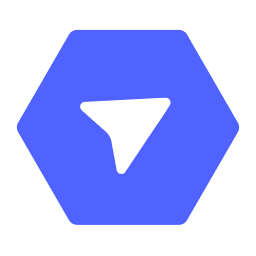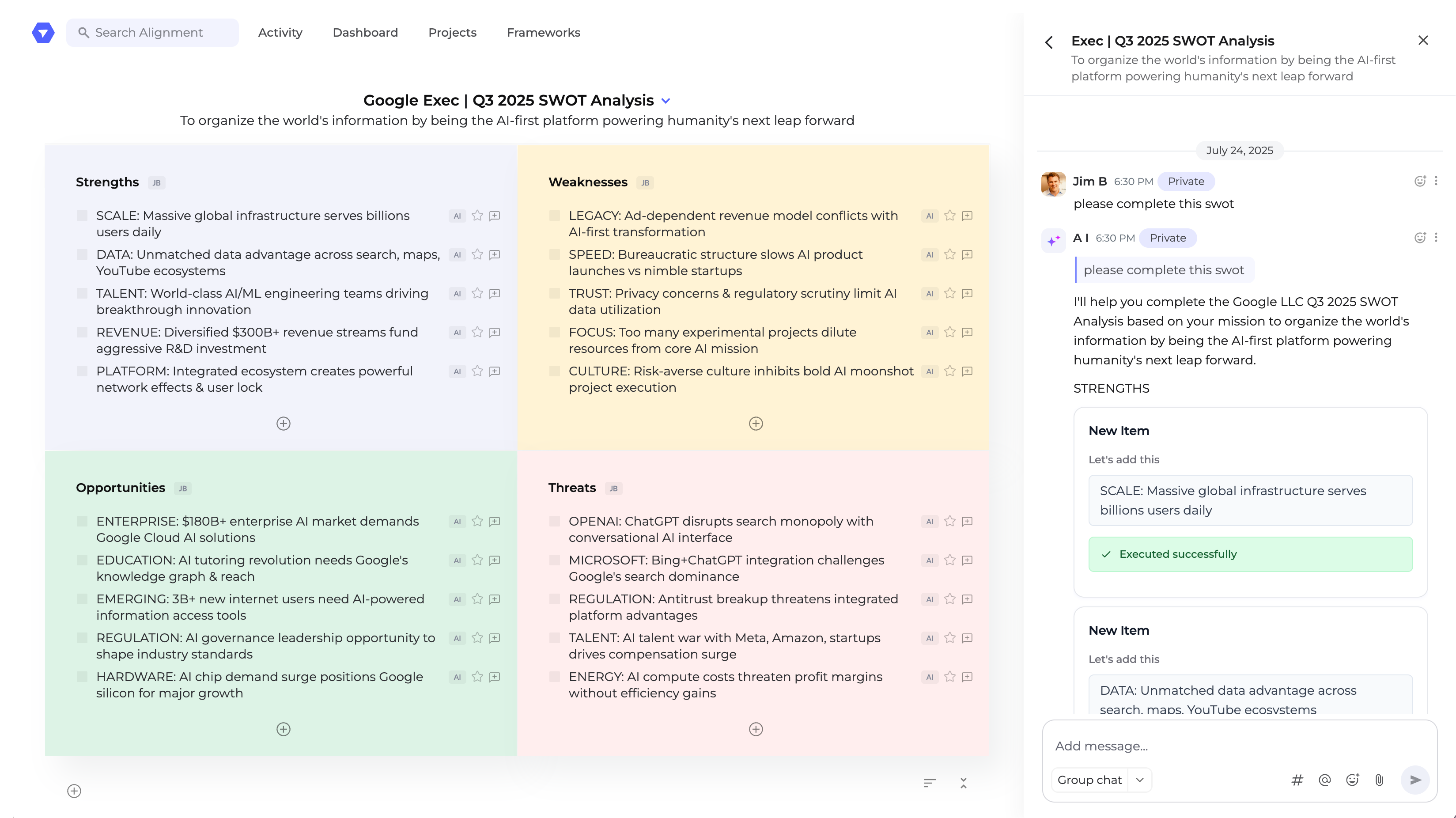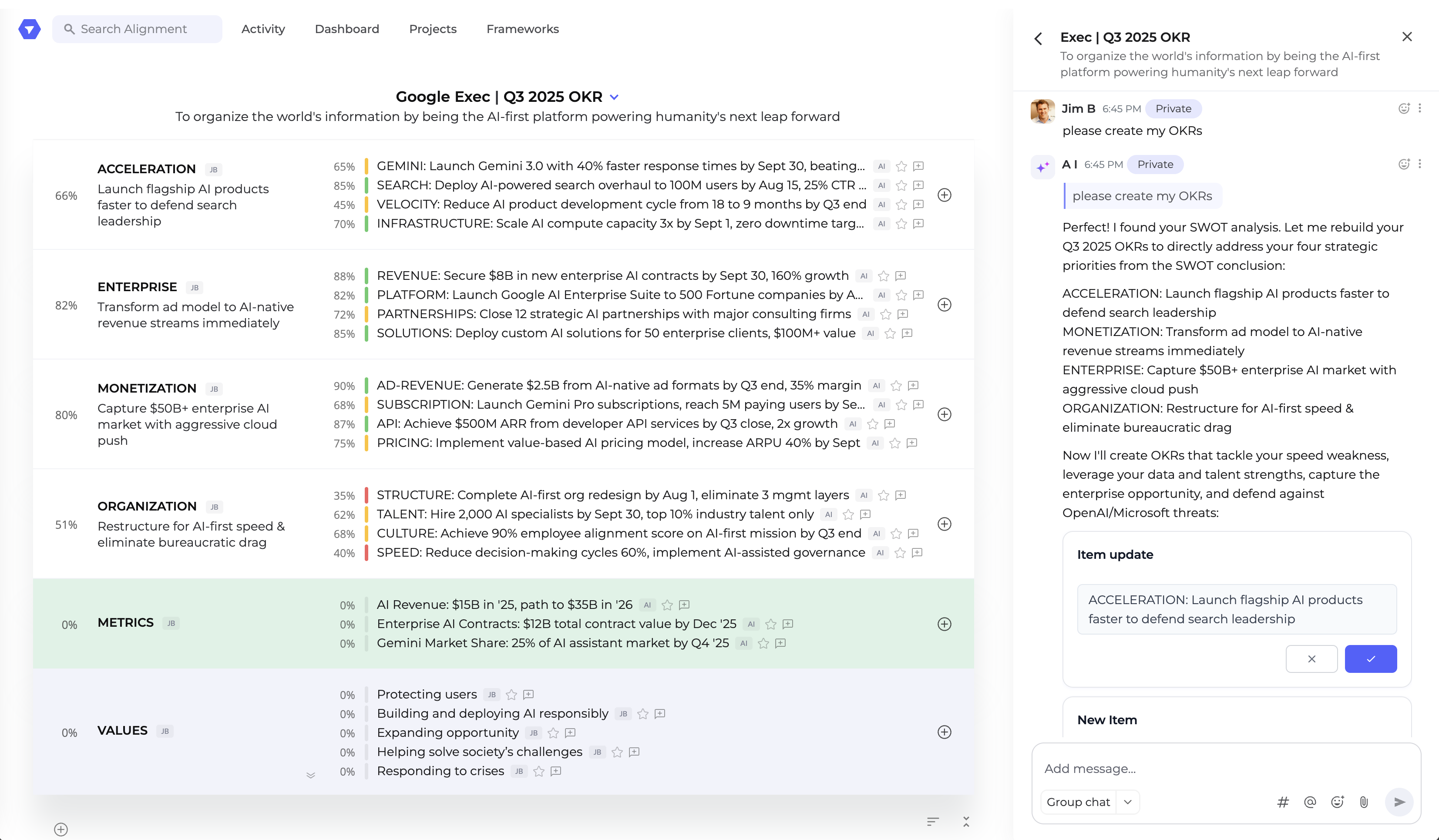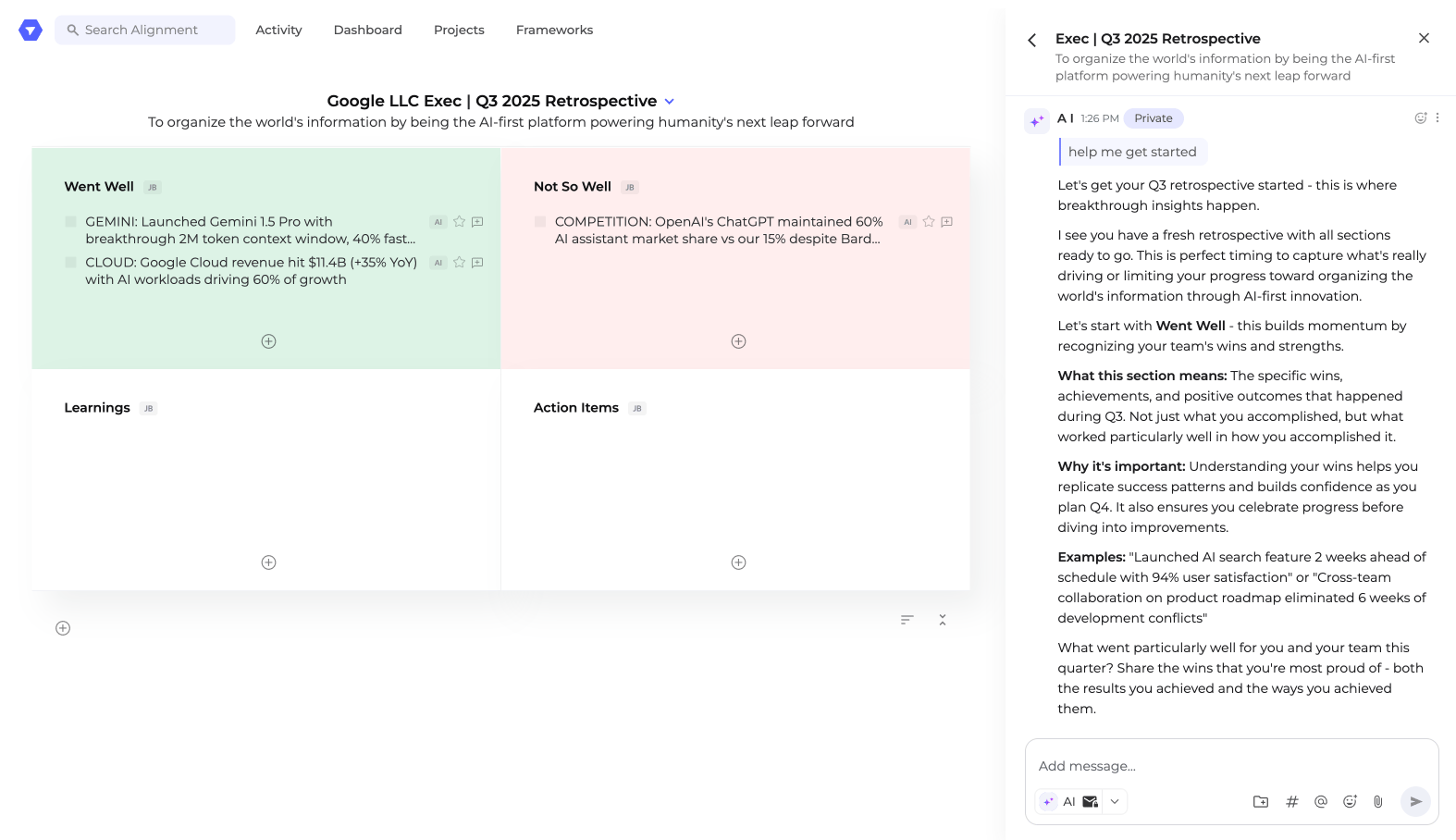Union Pacific Hr
To build America's premier railroad workforce by creating the most skilled and safety-focused team
| Organization | SWOT Analysis | OKR Plan | Top 6 | Retrospective |
|---|---|---|---|---|
|
To build America's premier railroad workforce by creating the most skilled and safety-focused team
|
5
5
5
5
|
|
|
4
4
4
4
|
SWOT Analysis
How to Use This Analysis
This analysis for Union Pacific was created using Alignment.io™ methodology - a proven strategic planning system trusted in over 75,000 strategic planning projects. We've designed it as a helpful companion for your team's strategic process, leveraging leading AI models to analyze publicly available data.
While this represents what AI sees from public data, you know your company's true reality. That's why we recommend using Alignment.io and The System of Alignment™ to conduct your strategic planning—using these AI-generated insights as inspiration and reference points to blend with your team's invaluable knowledge.
Powered by Leading AI Models
Industry-leading reasoning capabilities with 200K context window for comprehensive analysis
State-of-the-art multimodal intelligence with real-time market data processing and trend analysis
Advanced reasoning with comprehensive industry knowledge and strategic problem-solving capabilities
The SWOT analysis reveals Union Pacific HR faces a critical inflection point. While maintaining strong safety culture and competitive compensation, the looming retirement cliff threatens operational continuity. The organization must urgently modernize its talent acquisition strategy, accelerate digital upskilling, and build diverse pipelines. Success hinges on balancing traditional railroad expertise with next-generation workforce capabilities. Strategic partnerships and technology-enabled training will be essential for sustainable growth and mission achievement.
To build America's premier railroad workforce by creating the most skilled and safety-focused team
Strengths
- SAFETY: Industry-leading safety protocols with 22% injury reduction YoY
- SCALE: 32,000+ workforce managing 32,000+ mile rail network nationally
- COMPENSATION: Competitive wages averaging $78K+ with comprehensive benefits
- TRAINING: Established conductor/engineer training programs with 95% completion
- STABILITY: Low voluntary turnover at 8.2% vs industry average of 12%
Weaknesses
- AGING: 42% of workforce eligible for retirement within next 10 years
- HIRING: 18-month average time to fully train new locomotive engineers
- DIVERSITY: Only 23% diverse workforce in operations roles vs 35% target
- RETENTION: Difficulty attracting younger workers to traditional rail jobs
- SKILLS: Technology skill gaps as railroad digitizes operations systems
Opportunities
- AUTOMATION: AI and autonomous technology reducing physical job demands
- VETERANS: Large veteran population seeking stable transportation careers
- APPRENTICESHIPS: Government funding for rail transportation apprenticeship programs
- REMOTE: Digital roles enabling remote work attracting broader talent pool
- SUSTAINABILITY: ESG focus attracting environmentally conscious workers
Threats
- COMPETITION: Trucking/logistics companies offering higher starting wages
- SHORTAGE: National skilled trades worker shortage affecting all industries
- REGULATION: Potential crew size mandates increasing labor costs significantly
- ECONOMIC: Recession reducing freight volumes and workforce needs
- TECHNOLOGY: Automation potentially eliminating traditional railroad jobs
Key Priorities
- SUCCESSION: Develop comprehensive succession planning for retiring workforce
- ATTRACTION: Modernize employer brand to attract diverse, younger talent
- UPSKILLING: Accelerate technology training for digital transformation
- PIPELINE: Build partnerships with schools for continuous talent pipeline

Create Your Own AI SWOT Analysis
Generate comprehensive, data-driven SWOT analyses instantly with our AI-powered template. Uncover actionable insights and make strategic decisions with confidence.
Get Free SWOT Analysis TemplateOKR AI Analysis
How to Use This Analysis
This analysis for Union Pacific was created using Alignment.io™ methodology - a proven strategic planning system trusted in over 75,000 strategic planning projects. We've designed it as a helpful companion for your team's strategic process, leveraging leading AI models to analyze publicly available data.
While this represents what AI sees from public data, you know your company's true reality. That's why we recommend using Alignment.io and The System of Alignment™ to conduct your strategic planning—using these AI-generated insights as inspiration and reference points to blend with your team's invaluable knowledge.
Powered by Leading AI Models
Industry-leading reasoning capabilities with 200K context window for comprehensive analysis
State-of-the-art multimodal intelligence with real-time market data processing and trend analysis
Advanced reasoning with comprehensive industry knowledge and strategic problem-solving capabilities
This SWOT analysis-driven OKR plan strategically addresses Union Pacific's critical workforce challenges through four integrated objectives. The focus on pipeline development and retention directly counters the retirement cliff threat, while digitization modernizes HR capabilities for competitive advantage. Safety culture reinforcement maintains UP's core strength while building future-ready capabilities. Success requires disciplined execution across all four areas, with particular emphasis on speed of implementation given the urgency of workforce transitions facing the railroad industry.
To build America's premier railroad workforce by creating the most skilled and safety-focused team
BUILD PIPELINE
Create sustainable talent pipeline for critical railroad roles
RETAIN TALENT
Reduce turnover through engagement and development programs
DIGITIZE HR
Transform HR operations through AI and digital solutions
SAFETY CULTURE
Strengthen safety-first culture through training and engagement
METRICS
VALUES

Create Your Own AI OKR Template
Generate comprehensive, data-driven OKRs instantly with our AI-powered template. Set clear objectives, measurable key results, and track progress with confidence.
Get Free AI-Powered OKR TemplateTeam retrospectives are powerful alignment tools that help identify friction points, capture key learnings, and create actionable improvements. This structured reflection process drives continuous team growth and effectiveness.
Union Pacific Hr Retrospective
AI-Powered Insights
Powered by leading AI models:
Example Data Sources
- Union Pacific Q3 2024 earnings report showing 6.2% labor cost increase and workforce demographics
- Federal Railroad Administration safety statistics and injury frequency benchmarks for Class I railroads
- Bureau of Labor Statistics transportation industry employment data and wage comparisons
- Union Pacific investor presentations on digital transformation and operational efficiency initiatives
To build America's premier railroad workforce by creating the most skilled and safety-focused team
What Went Well
- SAFETY: Achieved record-low injury frequency rate of 0.75 per 200,000 hours
- EFFICIENCY: Improved train crew productivity by 8% through operational changes
- RETENTION: Maintained conductor retention rate above 85% industry benchmark
- DIVERSITY: Increased diverse hiring in management roles by 15% year-over-year
Not So Well
- HIRING: Missed locomotive engineer hiring target by 12% due to market conditions
- COSTS: Labor costs increased 6.2% above budget due to overtime premiums
- TURNOVER: Experienced higher than expected retirements in Q2 and Q3
- TRAINING: Training backlogs increased to 14 weeks for new conductor programs
Learnings
- MARKET: Tight labor market requires more competitive compensation packages
- PLANNING: Need better predictive analytics for retirement forecasting
- FLEXIBILITY: Remote work options essential for attracting office-based talent
- SPEED: Faster onboarding processes critical for competitive talent acquisition
Action Items
- WAGES: Benchmark and adjust starting wages for key shortage positions
- ANALYTICS: Implement workforce planning software for better forecasting
- PROCESS: Streamline hiring process to reduce time-to-hire by 25%
- PARTNERSHIPS: Establish community college partnerships for talent pipeline

Create Your Own AI Retro Template
Generate comprehensive, data-driven retrospectives instantly with our AI-powered template. Reflect on what went well, identify improvements, and create actionable learnings with confidence.
Get Free AI-Powered Retro TemplateAI Strategy Analysis
How to Use This Analysis
This analysis for Union Pacific was created using Alignment.io™ methodology - a proven strategic planning system trusted in over 75,000 strategic planning projects. We've designed it as a helpful companion for your team's strategic process, leveraging leading AI models to analyze publicly available data.
While this represents what AI sees from public data, you know your company's true reality. That's why we recommend using Alignment.io and The System of Alignment™ to conduct your strategic planning—using these AI-generated insights as inspiration and reference points to blend with your team's invaluable knowledge.
Powered by Leading AI Models
Industry-leading reasoning capabilities with 200K context window for comprehensive analysis
State-of-the-art multimodal intelligence with real-time market data processing and trend analysis
Advanced reasoning with comprehensive industry knowledge and strategic problem-solving capabilities
Union Pacific's AI strategy reveals significant potential to revolutionize HR operations while addressing workforce challenges. The company's rich operational data and technology investment position it well for AI adoption. However, skills gaps and cultural resistance require careful change management. Prioritizing ethical AI governance, building internal capabilities, and starting with high-impact pilots will ensure successful transformation while maintaining employee trust and regulatory compliance.
To build America's premier railroad workforce by creating the most skilled and safety-focused team
Strengths
- DATA: Extensive operational data from 32,000+ miles for AI training models
- INFRASTRUCTURE: Existing digital backbone supporting AI implementation
- PARTNERSHIPS: Strong vendor relationships with tech companies for AI solutions
- BUDGET: Significant capital allocation for technology modernization initiatives
- LEADERSHIP: C-suite commitment to digital transformation and AI adoption
Weaknesses
- SKILLS: Limited AI/ML expertise within current HR and IT workforce
- CULTURE: Traditional workforce resistant to AI-driven process changes
- INTEGRATION: Legacy HR systems incompatible with modern AI platforms
- GOVERNANCE: Lack of AI ethics framework for HR decision-making processes
- ANALYTICS: Insufficient data science capabilities for AI model development
Opportunities
- RECRUITMENT: AI-powered talent matching and candidate screening systems
- PREDICTIVE: Machine learning for workforce planning and turnover prediction
- TRAINING: VR/AR AI-enhanced safety and technical skills training programs
- ENGAGEMENT: AI chatbots for employee services and engagement initiatives
- ANALYTICS: Real-time workforce analytics for data-driven HR decisions
Threats
- BIAS: AI algorithms potentially creating discriminatory hiring practices
- PRIVACY: Data privacy concerns with AI monitoring employee performance
- DISPLACEMENT: AI automation reducing need for traditional HR roles
- COMPLIANCE: Regulatory requirements for AI transparency in employment
- SECURITY: Cybersecurity risks from AI systems handling employee data
Key Priorities
- PLATFORM: Implement AI-powered HR platform for recruitment and analytics
- GOVERNANCE: Establish AI ethics committee for responsible HR AI deployment
- CAPABILITIES: Build internal AI expertise through hiring and training
- PILOT: Launch AI chatbot pilot for employee services and engagement

Create Your Own AI SWOT Analysis
Generate comprehensive, data-driven SWOT analyses instantly with our AI-powered template. Uncover actionable insights and make strategic decisions with confidence.
Get Free SWOT Analysis Template



